It’s easy to confuse eczema and psoriasis. Both cause red, itchy, flaky skin. Both can show up on the elbows, knees, or scalp. But they’re not the same condition - and treating them the wrong way can make things worse. The real difference isn’t just in symptoms. It’s in how the rash looks, where it shows up, and what happens when you scratch or scrape it.
Location Tells the First Story
If you see a rash inside the bend of your elbow or behind the knee, it’s far more likely to be eczema. About 92% of eczema cases show up in these skin folds - places where skin rubs against skin. The same goes for the inner wrists, ankles, and the cheeks of babies. These are called flexural areas, and eczema loves them.
Psoriasis, on the other hand, shows up on the outside. Think the outer elbows, front of the knees, scalp, lower back, and nails. These are extensor surfaces - the parts of your body that stretch out when you move. A dermatologist will often say it this way: eczema inside the creases, psoriasis outside the creases. That’s not just a saying - it’s backed by data. One study of over 1,200 patients found that 94.7% of eczema cases involved flexural areas, while 88.6% of psoriasis cases hit extensor surfaces.
There’s an exception: inverse psoriasis. It does appear in skin folds - like under the breasts or in the groin. But it looks different. Instead of thick, scaly patches, it’s smooth, shiny, and red without the heavy white buildup. That’s a key clue.
What the Rash Actually Looks Like
Eczema doesn’t have clean edges. It blends into normal skin, looking patchy and irregular. On lighter skin, it’s red and inflamed. On darker skin, it often looks ashen, gray, or purple - not bright red. The surface is usually dry, but in flare-ups, it can weep, ooze, or crust over. Chronic eczema leads to lichenification - skin that thickens and becomes leathery from constant scratching.
Psoriasis is the opposite. It’s bold. Defined. It doesn’t fade into the background. Plaque psoriasis - the most common form - shows up as raised, thick patches with a clear border. The scales are heavy, silvery-white, and stick tightly to the skin. You can’t just wipe them off. They cling like armor.
Here’s a simple test: gently scrape the edge of the patch with a glass slide or your fingernail. If it bleeds in tiny dots, that’s the Auspitz sign - a hallmark of psoriasis. It happens because the rapid skin cell growth pushes blood vessels up close to the surface. Eczema doesn’t do this. It flakes fine and doesn’t bleed when scraped.
Nails Don’t Lie
Psoriasis doesn’t just affect the skin. It attacks the nails. Half of people with psoriasis develop pitting - tiny dents that look like the nail was punched with a pin. About 80% experience onycholysis, where the nail lifts away from the nail bed. The nail might turn yellow, crumble, or separate completely.
Eczema rarely touches the nails. If it does, you might see ridges or discoloration - but never true pitting. Nail changes are one of the clearest signs you’re dealing with psoriasis, not eczema.
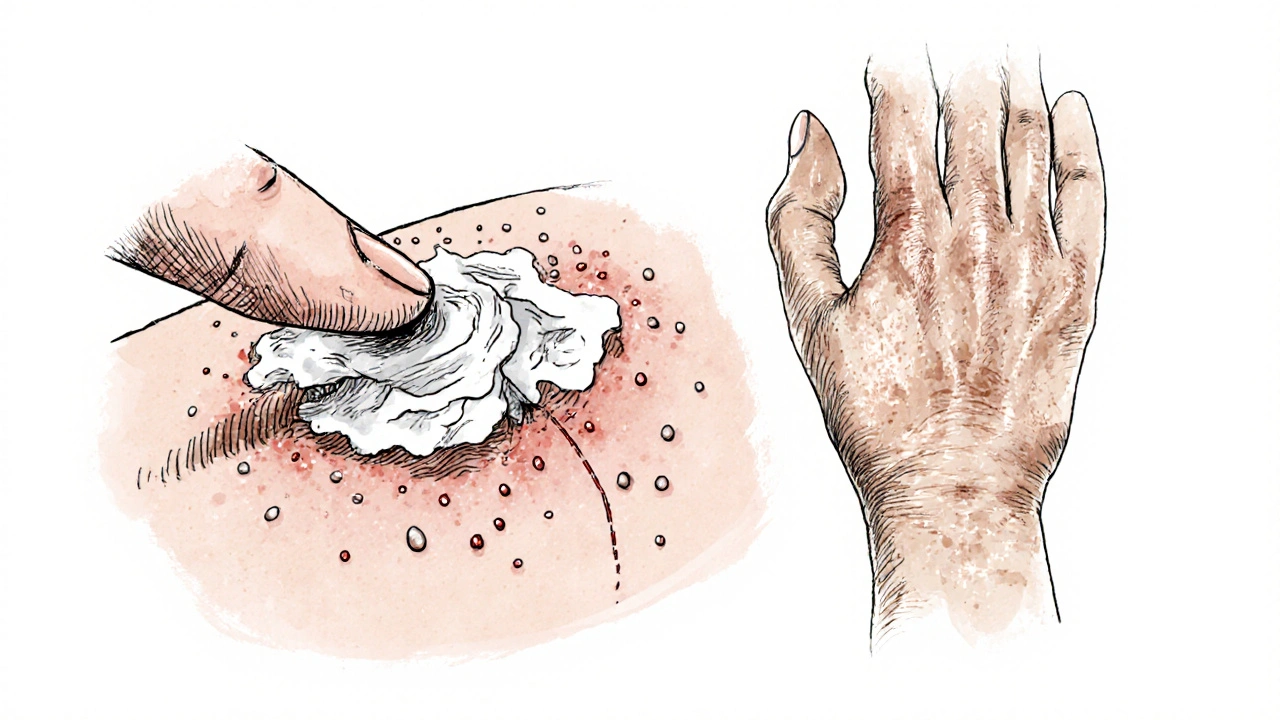
Texture and Behavior Over Time
Eczema is unpredictable. It flares up after soap, sweat, stress, or dry air. One day it’s dry and flaky, the next it’s wet and weeping. It comes and goes. That’s why people describe it as “raw-looking” skin that cracks and bleeds easily.
Psoriasis is more stubborn. Once a plaque forms, it stays. It doesn’t ooze. It doesn’t weep. It just sits there - thick, scaly, and stubborn. The scales build up over weeks. And if you scratch or injure the skin? Psoriasis can spread to that spot. This is called the Koebner phenomenon. It happens in 25-30% of psoriasis patients. It’s rare in eczema.
How Skin Tone Changes the Picture
Most textbooks show eczema and psoriasis on white skin. But 70% of the U.S. population has skin tones that are medium to dark. And the appearance changes dramatically.
On darker skin, eczema doesn’t look red. It looks darker - hyperpigmented - or lighter - hypopigmented. The scaling is subtle. It’s easy to miss. That’s why misdiagnosis rates are 35% higher for people with Fitzpatrick skin types IV-VI.
Psoriasis on dark skin isn’t bright red either. It appears as deep violet, brown, or gray patches. But the silvery scales are still there - and they’re the giveaway. Recent research found that 68% of psoriasis cases on darker skin show a unique “halo” of lighter skin around the active patches. That’s something you won’t see in eczema.
A 2023 survey of 500 dermatologists found that 68% felt undertrained to diagnose these conditions on darker skin. That’s why delays in diagnosis average 14.3 months for people of color - compared to just 5.2 months for white patients.
What Patients Actually Say
People living with these conditions describe them differently - and their words match the science.
On eczema forums, 87% say their skin looks “raw,” “weepy,” or “cracked.” They talk about bleeding from scratching. On psoriasis forums, 89% mention “thick, silvery scales.” One Reddit user called it “like my skin put on a suit of armor.”
Another key insight: psoriasis patients are 3.2 times more likely to say their rash is “visually distinctive.” Eczema patients say theirs blends in. That’s because psoriasis has clear borders and heavy scaling. Eczema is messy, fuzzy, and inconsistent.
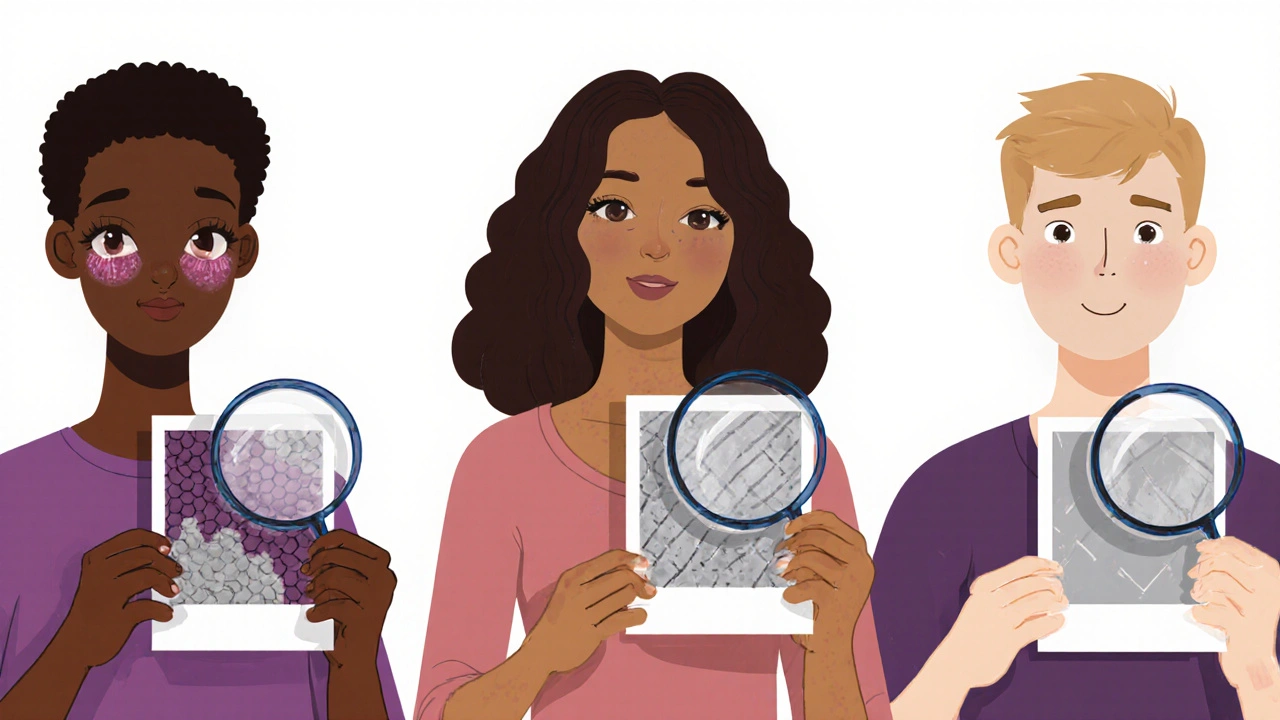
Tools That Help - and Their Limits
There are tools now that can help spot the difference. Teledermatology apps use AI to analyze photos. One system, approved by the FDA in January 2024, can tell eczema from psoriasis with 85% accuracy by comparing your rash to 250,000 verified cases.
But here’s the catch: those tools are less accurate on darker skin. Studies show they’re 22% less reliable for skin types V-VI. Why? Because the training data was mostly from lighter skin tones.
There’s also multispectral imaging - a lab technique that measures how skin reflects light at different wavelengths. Psoriasis and eczema reflect light differently. In a 2023 study, this method was 92.7% accurate. But you can’t buy this device at a drugstore.
The best tool you have? Your eyes. And a good photo. Take pictures of your rash under the same lighting every week. Psoriasis stays the same. Eczema changes fast. That’s a powerful tracker.
When to See a Dermatologist
If you’re unsure, don’t guess. Misdiagnosis happens in 15-20% of cases, according to the Journal of the American Academy of Dermatology. Using the wrong cream can make psoriasis worse - and eczema can turn chronic if not managed properly.
See a dermatologist if:
- Your rash doesn’t improve after two weeks of over-the-counter moisturizers
- You notice nail changes - pitting or lifting
- The rash bleeds when you scrape it
- You have a family history of psoriasis or autoimmune disease
- You have dark skin and your rash doesn’t look like the pictures you see online
Don’t wait. Early, accurate diagnosis means better control. And for psoriasis, early treatment can prevent joint damage - a complication called psoriatic arthritis.
Final Takeaway
Eczema is messy, itchy, and unpredictable. It hides in the folds, weeps, and fades. Psoriasis is bold, thick, and stubborn. It stands out on the outside, scales up, and doesn’t budge.
The location, the scale, the bleeding, the nails - these aren’t minor details. They’re diagnostic landmarks. And with better awareness - especially around skin of color - we’re getting better at telling them apart.
Know what you’re dealing with. Not because you want to self-diagnose - but because you deserve the right treatment. And that starts with seeing the difference clearly.
Can eczema turn into psoriasis?
No. Eczema and psoriasis are two separate conditions with different causes. Eczema is triggered by environmental irritants and a weakened skin barrier. Psoriasis is an autoimmune disorder where the immune system attacks healthy skin cells. One cannot transform into the other. But someone can have both at the same time - it’s rare, but possible.
Does scratching make psoriasis worse?
Yes - but not because it spreads the rash. Scratching can trigger the Koebner phenomenon, where new psoriasis plaques form at the site of skin injury. That means scratching one patch can cause another to appear nearby. It doesn’t make the original patch bigger, but it can multiply the number of lesions. Eczema also gets worse with scratching, but for different reasons - it breaks the skin barrier and increases inflammation.
Are psoriasis scales contagious?
No. Neither psoriasis nor eczema is contagious. You can’t catch it from touching someone’s rash, sharing towels, or swimming in the same pool. Psoriasis scales are just dead skin cells building up too fast. They’re not infectious. The confusion often comes from how thick and flaky they look - but they’re not like a fungal infection or virus.
Why does psoriasis look different on dark skin?
Because melanin affects how inflammation appears. On lighter skin, redness from inflammation is easy to see. On darker skin, the same inflammation shows up as darker brown, purple, or gray patches. The silvery scales are still there, but the base color changes. This is why many dermatologists miss psoriasis in people of color - they’re looking for red plaques and don’t recognize the darker variants. Recent studies have mapped these differences, and new diagnostic guides now include skin of color presentations.
Can I use the same cream for eczema and psoriasis?
Some over-the-counter moisturizers work for both - like fragrance-free emollients. But prescription treatments differ. Eczema often responds to topical steroids and calcineurin inhibitors. Psoriasis needs stronger options like vitamin D analogs, coal tar, or biologics. Using a psoriasis treatment on eczema can irritate sensitive skin. Using an eczema cream on thick psoriasis plaques won’t penetrate enough. Always check with a dermatologist before switching treatments.
Is there a blood test to tell them apart?
No. Neither eczema nor psoriasis has a definitive blood test. Diagnosis is based on appearance, location, medical history, and sometimes a skin biopsy. A biopsy can show the difference under the microscope - eczema shows spongiotic changes, psoriasis shows thickened layers and immune cell buildup. But most doctors can diagnose by sight alone, especially when they know what to look for.
Can stress cause either condition?
Stress doesn’t cause either, but it’s a major trigger for both. For eczema, stress weakens the skin barrier and increases inflammation. For psoriasis, stress activates the immune system, speeding up skin cell turnover. Many patients report flares after major life events - job loss, divorce, illness. Managing stress won’t cure either, but it’s one of the most effective ways to reduce flare frequency.

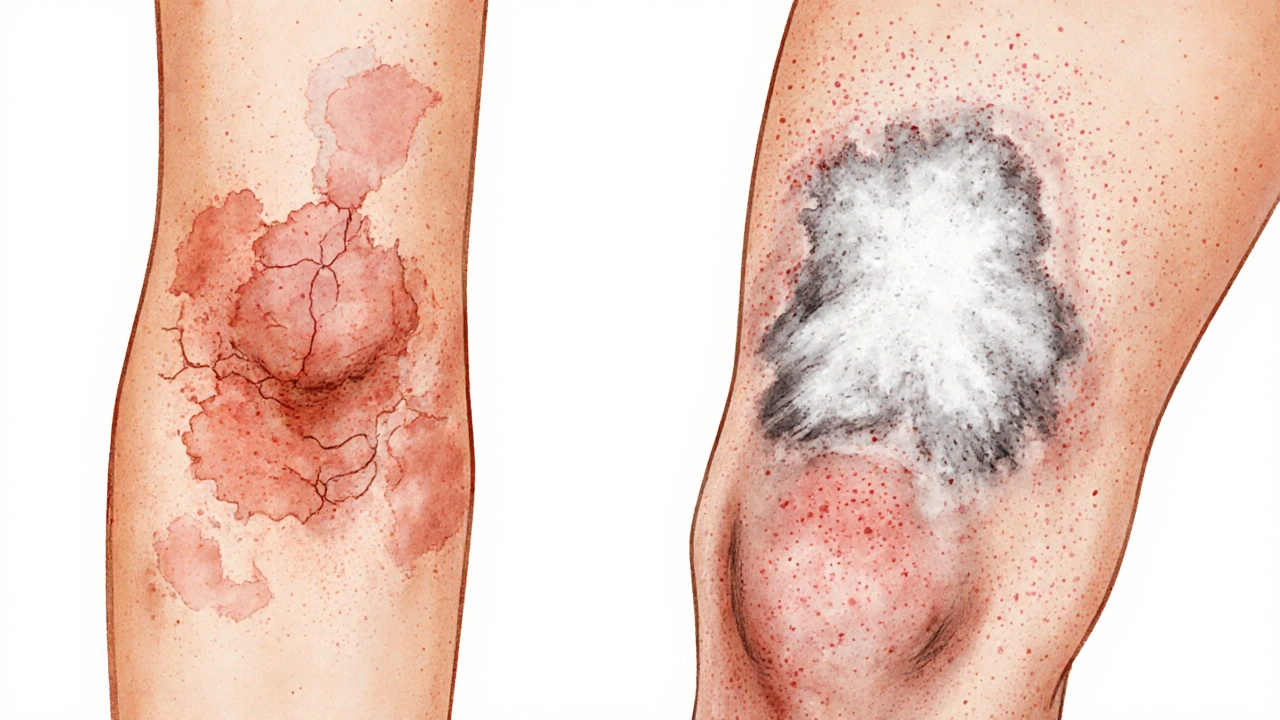
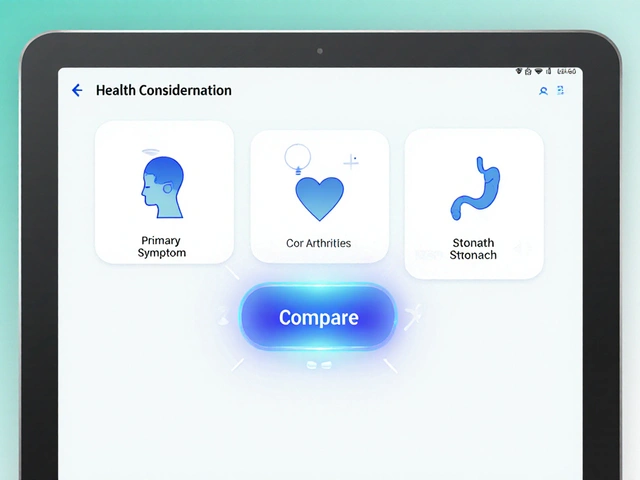
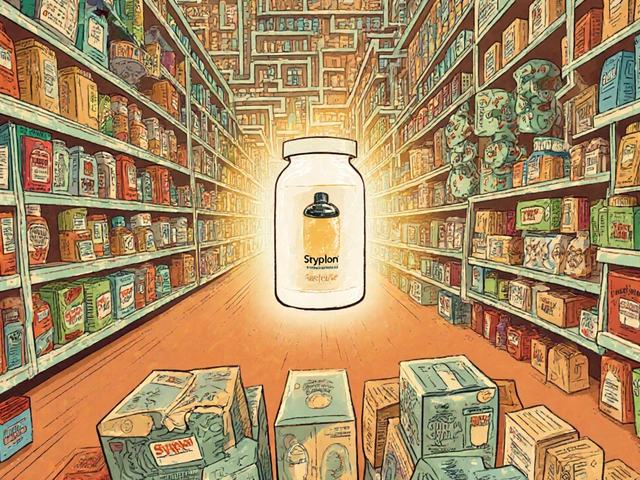



Aidan McCord-Amasis
November 15, 2025 AT 23:01 PMThick scales? Check. Silvery? Check. My knee looks like a dragon shed its armor. 🐉
Katie Baker
November 16, 2025 AT 21:42 PMI’ve had eczema since I was a kid and this post literally made me cry. Not because it’s sad - because for once, someone explained what my skin actually looks like. Thank you.
Also, the part about darker skin? YES. I’ve been told I just have ‘dry skin’ for years. 😭
Ryan Airey
November 18, 2025 AT 15:05 PMLet’s be real - most of this is common sense if you’ve ever seen a dermatologist. But the data? 94.7% flexural for eczema? That’s not a hunch, that’s a forensic signature. And the Auspitz sign? That’s the golden ticket.
Also, the fact that AI tools are 22% less accurate on darker skin isn’t a bug - it’s systemic racism baked into algorithms. Someone’s training data is still stuck in 2008.
And don’t get me started on how insurance refuses to cover multispectral imaging. It’s not about cost - it’s about who gets seen.
Stop calling it ‘skin tone.’ Call it ‘pigmentation variance.’ Language matters.
Also, psoriatic arthritis is a silent killer. If you’ve got psoriasis and your knuckles crack when you open jars? Go. Now.
And yes, scratching causes Koebner. But so does a damn Band-Aid. I once got a new plaque where I peeled off a sticker. Don’t ask.
Stop using ‘eczema cream’ on psoriasis. It’s like putting duct tape on a ruptured pipe.
And no - stress doesn’t cause it. But if you’re stressed, your immune system is already on red alert. You’re not the problem. Your body’s just screaming.
And for the love of god, stop Googling ‘is my rash contagious?’ No. It’s not. You’re not a walking biohazard. You’re a human with a malfunctioning skin cycle.
And if your dermatologist says ‘just moisturize’ and leaves? Find a new one. This isn’t 1998.
Finally - the halo effect on dark skin? That’s real. I’ve seen it. It’s like a faint glow around the lesion. Like a spiritual aura. Weird? Yeah. Accurate? Also yes.
Know your skin. Not because you’re a nerd. Because you deserve to not be misdiagnosed for 14 months.
Edward Ward
November 19, 2025 AT 03:17 AMThank you for including the nail changes - I didn’t realize pitting was such a tell. I thought my nails were just ‘bad’ until I saw a photo of my cousin’s hands and realized we both had the same thing.
Also, the Koebner phenomenon is terrifying - I got a new patch right where I scratched a mosquito bite last summer. It’s still there. Like a scar that decided to stay.
And the part about ‘raw’ vs. ‘armor’ skin? That’s poetic, but also medically precise. Eczema feels like your skin is peeling off in real time. Psoriasis feels like your skin is trying to build a fortress. Two different wars.
And I’m glad you mentioned the 68% of dermatologists feeling undertrained. That’s not a failure of patients - it’s a failure of education. Medical schools still teach dermatology using 90% white skin images. It’s outdated. Dangerous.
Also, the fact that psoriasis scales don’t come off easily? That’s because they’re not just dead skin - they’re a product of hyperproliferation. It’s not dandruff. It’s a biological glitch.
And the emotional toll? Nobody talks about how it feels to have your skin look like it’s been burned - and then have people ask if you’re ‘clean.’
Thank you for not sugarcoating this. Most articles treat it like a cosmetic issue. It’s not. It’s immunological. It’s systemic. It’s invisible until it’s not.
Hollis Hollywood
November 19, 2025 AT 10:42 AMI’ve lived with both conditions at different times, and honestly? It’s like having two different versions of the same pain. Eczema is the clingy ex - always showing up when you’re stressed, never leaving you alone. Psoriasis is the cold, distant relative who shows up once a year, looks you in the eye, and says, ‘I’m not going anywhere.’
I used to think I was just ‘sensitive.’ Turns out, my skin was screaming. And no one was listening.
My mom used to rub coconut oil on my arms and say, ‘That’ll fix it.’ It didn’t. But it made me feel loved.
I wish more people understood that this isn’t about hygiene. It’s not about ‘not washing enough.’ It’s biology. It’s genetics. It’s your immune system throwing a tantrum.
And the part about darker skin? I’m mixed race, and I spent years thinking my patches were just ‘dark spots.’ No one told me they were psoriasis until I was 28. That’s too late.
I’m glad someone wrote this. Not just for the facts - but because it makes people like me feel less alone.
Also, the ‘halo’ thing? I’ve seen it. It’s like a ghost outline around the patch. I thought it was a trick of the light. Turns out, it’s science.
Thank you for writing this. I’m sharing it with my family. They still think I’m ‘just itchy.’
Adam Dille
November 19, 2025 AT 22:55 PMJust wanted to say - I’m 32 and just got diagnosed with psoriasis last year. I thought it was just ‘bad dandruff’ on my elbows. I used hydrocortisone for months. Nothing.
Then I saw a dermatologist who asked me about my nails. I said, ‘They’re fine.’ She said, ‘Look again.’
Turns out, I had pitting. Tiny little holes. Like someone took a pin to my nails. I cried.
But also - I felt seen.
Thank you for explaining the difference in texture. Eczema feels like sandpaper. Psoriasis feels like concrete. One’s dry. One’s… armored.
And the Koebner thing? I got a new patch where I got a sunburn. I didn’t know that was a thing. Now I’m paranoid about every scratch.
But hey - at least I know now. And that’s half the battle.
Also - psoriasis isn’t contagious. I’ve had people avoid me like I have the plague. It’s exhausting.
Thanks for the clarity. I’m printing this out and showing my boss. He thinks I’m ‘just being dramatic.’
Ogonna Igbo
November 21, 2025 AT 18:45 PMMy people in Nigeria, we call this ‘spiritual skin.’ No one knows what it is. Doctors say ‘allergy.’ Then they give you cream that burns. Then you stop going.
But I know - this is not allergy. This is blood. This is family. My uncle had it. My cousin. My aunt. It’s in our bones.
They say ‘psoriasis’ but we don’t say that. We say ‘the mark.’
You don’t scratch it. You pray over it. You wash with bitter leaf. You don’t tell people. You hide.
Now I see - it’s not magic. It’s science. And I’m not cursed.
Thank you for saying this. I will tell my sister. She’s 16. She hides her legs. She’s ashamed.
We are not dirty. We are not broken.
We are just different.
And now I know how to explain it.
God bless you.
- Ogonna
BABA SABKA
November 22, 2025 AT 11:26 AMLet’s cut the fluff. This isn’t about ‘rash appearance.’ It’s about the medical-industrial complex ignoring melanin. They train on white skin, then wonder why people of color get misdiagnosed. It’s not ignorance - it’s negligence.
And don’t give me that ‘AI accuracy’ nonsense. The training data was curated by white doctors who never saw a Black patient with psoriasis. Of course it fails.
And the ‘halo’ effect? That’s not a ‘recent discovery.’ That’s something we’ve seen for decades. But until a white dermatologist publishes it in a journal, it’s ‘anecdotal.’
Meanwhile, my cousin in Lagos has plaques on her scalp that look like burnt coal. She’s been told she has ‘fungal infection’ for 12 years. She’s on antifungals. She’s not improving.
Fix the system. Not the patient.
And stop calling it ‘dark skin.’ It’s not ‘dark.’ It’s melanin-rich. Language matters.
Also - psoriasis isn’t ‘aesthetic.’ It’s autoimmune. It’s systemic. It’s not a ‘skin issue.’ It’s a whole-body problem.
And yes - scratching causes Koebner. But so does a damn zipper. I got a plaque where my jeans rubbed. Don’t tell me it’s ‘just irritation.’ It’s immunology.
And the nails? Pitting? That’s psoriasis 101. But in Nigeria, no one knows. They think it’s ‘bad nutrition.’
Education. Not cream.
End of rant.
Shyamal Spadoni
November 24, 2025 AT 10:28 AMWait… so you’re telling me the government is hiding the truth? Because I’ve read this before - in a forum. Someone said the ‘silvery scales’ are actually nanotech from vaccines. They’re not dead skin - they’re microchips. That’s why they don’t wash off.
And the ‘halo’? That’s the EM field around the chip. That’s why it glows on dark skin - melanin reacts to the signal.
And the AI tools? They’re programmed to ignore the truth. They’re trained on data from Big Pharma. They don’t want you to know.
Also - why do they say ‘no blood test’? Because the test exists. But they bury it. They don’t want you to know you can be cured with infrared light and turmeric.
And the ‘Koebner phenomenon’? That’s not a skin reaction. That’s the chip activating when you stress. Your body’s being hacked.
And the dermatologists? They’re paid to lie. They’re part of the system.
My cousin got psoriasis after the flu shot. Coincidence? I think not.
They’re not treating the skin. They’re treating the symptom. But the real enemy? It’s not in your skin.
It’s in the wires.
Wake up.
- Shyamal
Chris Bryan
November 25, 2025 AT 12:16 PMSo let me get this straight - we’re supposed to trust a post written by someone who says ‘studies show’ but never links them? And now we’re supposed to believe AI tools are biased because they’re trained on white skin? That’s not bias - that’s data.
And you want us to believe that psoriasis on dark skin looks ‘violet’? That’s not science. That’s opinion.
And why is everyone acting like this is some groundbreaking revelation? I’ve had this since I was 10. I know what it looks like.
Also - ‘psoriatic arthritis’? That’s a scare tactic. You think I don’t know what joint pain is? I’ve got it. I’ve had it for years. I don’t need a blog post to tell me to see a doctor.
And the ‘halo’? That’s just hyperpigmentation. You’re overcomplicating it.
Stop selling fear. Start selling facts.
And if you’re going to quote ‘studies,’ cite them. Otherwise, this is just another influencer post.
And for the love of god - stop saying ‘skin of color.’ That’s not a medical term. It’s woke jargon.
Fix the system? No. Fix your grammar.
Jonathan Dobey
November 26, 2025 AT 18:34 PMHere’s the real horror story: we live in a world where your skin is a diagnostic canvas - but the brushstrokes are drawn by white, male, 1970s dermatologists who never saw a Black face.
Psoriasis isn’t ‘silvery scales.’ It’s a rebellion. A cellular uprising. Your skin cells are multiplying like a cult that refuses to die.
Eczema? That’s the quiet collapse. The slow unraveling. The skin forgetting how to be skin.
And the nails? They’re not ‘pitted.’ They’re scarred by the war inside you.
The ‘halo’? That’s the aura of your immune system screaming. It’s not a visual trick. It’s a metaphysical echo.
And the AI? It’s not biased. It’s just a mirror. It reflects the ignorance of its creators.
We are not patients. We are battlegrounds.
And the worst part? No one wants to hear it.
So we suffer in silence.
Until someone writes this.
And then - we breathe.
- Jonathan
Jessica Chambers
November 28, 2025 AT 11:46 AMWow. Finally, someone didn’t say ‘just moisturize.’ 😏
Also, the part about ‘raw’ vs. ‘armor’? That’s the most accurate thing I’ve read all year. I’m printing this and taping it to my bathroom mirror.
And yes - I’ve been told I’m ‘too dramatic’ for having psoriasis. I’m like, ‘Sir, I have a plaque on my elbow that looks like a lizard shed its skin.’
Thanks for not sugarcoating it. 💅
ASHISH TURAN
November 29, 2025 AT 14:49 PMAs someone from India, I’ve seen this in my family for generations. My grandmother called it ‘jwara ka rash’ - fever rash. She didn’t know it was psoriasis. She just knew it didn’t go away.
And yes - the scales? We used to scrape them off with coconut oil and a spoon. It hurt. But we did it anyway.
Now I know why. It’s not dandruff. It’s biology.
And the nail thing? My uncle lost three nails. He thought he had fungus. Took 15 years to get the right diagnosis.
Thank you for writing this. I’m sharing it with my cousins. They’re still ashamed.
It’s not their fault. It’s the system.
- Ashish
Andrew Eppich
December 1, 2025 AT 12:22 PMWhile the general observations presented are not entirely without merit, the tone and framing of this article betray a concerning trend toward emotional manipulation under the guise of medical education. The use of terms such as ‘armor’ and ‘raw’ is not clinically precise and risks anthropomorphizing physiological processes. Furthermore, the implicit criticism of dermatological training institutions is both unsubstantiated and unprofessional. Medical diagnosis remains a clinical art grounded in evidence, not anecdotal narrative. One does not require a ‘halo’ to identify psoriasis - one requires a trained eye and a biopsy when necessary. The overreliance on visual cues without proper diagnostic rigor is a disservice to the field. This is not empowerment. It is sensationalism dressed in science.
John Foster
December 3, 2025 AT 08:57 AMWhat if the rash isn’t a symptom at all? What if it’s a message?
Eczema - the skin weeping because it’s tired of being ignored.
Psoriasis - the skin shouting because it’s been silenced for too long.
We treat them like malfunctions. But what if they’re awakenings?
Maybe your skin isn’t broken. Maybe it’s trying to tell you something.
Maybe the scales aren’t dead cells - they’re the armor you didn’t know you needed.
Maybe the itching isn’t irritation - it’s your body asking you to stop.
To slow down.
To feel.
And maybe - just maybe - the reason we can’t diagnose it properly is because we’re not listening.
We’ve turned skin into a problem to fix.
But what if it’s a portal?
- John
Ryan Airey
December 3, 2025 AT 23:57 PMJohn, you’re either a poet or a cult leader. I’m not sure which. But I’m sharing this with my therapist.
Also - the Koebner phenomenon? I got a new patch where I wore a tight watch for a week. So yeah. It’s not just stress. It’s friction. It’s pressure. It’s every damn zipper, bra strap, and sock seam.
And yes - I’m now paranoid about my socks.
Thanks for the poetry. Now go write a book.